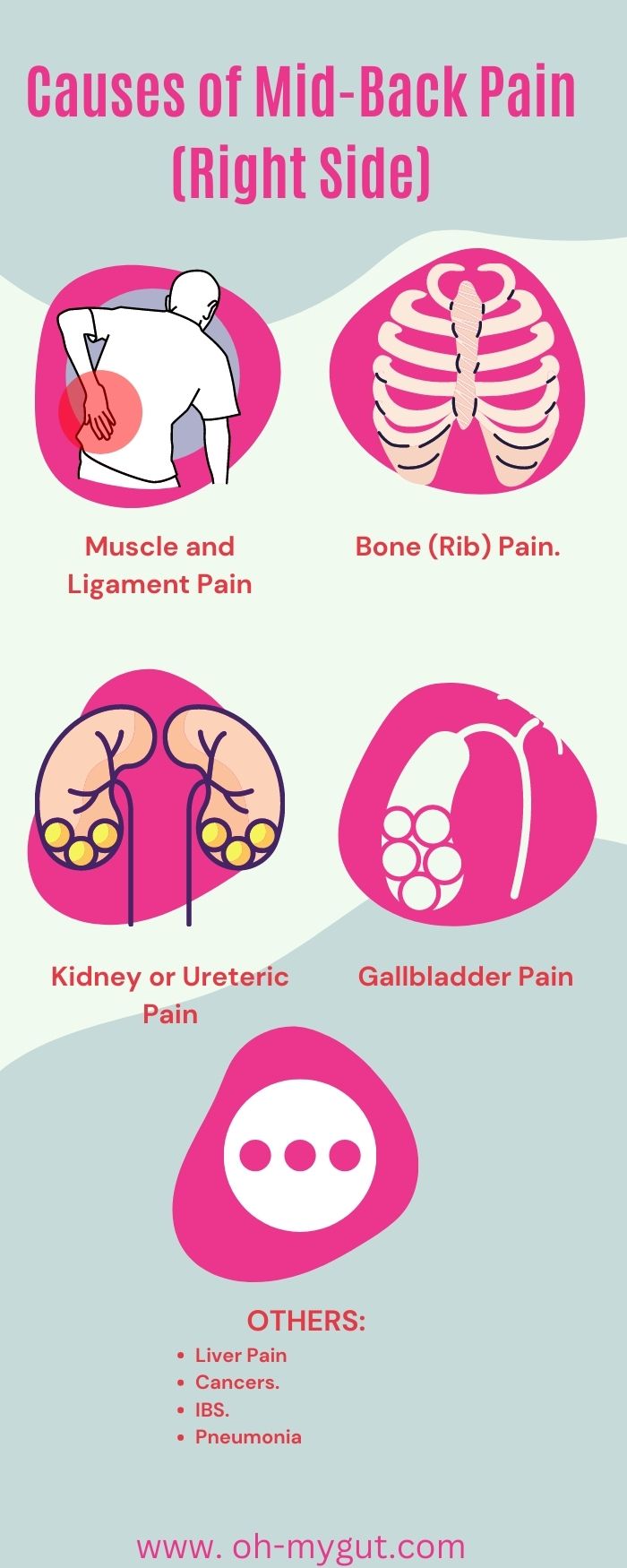Mid Back Pain (Right Side): 6 Causes & How to Differentiate.
Our content is not intended nor recommended as a substitute for medical advice by your doctor. Use for informational purposes only.
The Short Answer:
Common causes of mid-back pain on the right side include muscle, tendon, ligament sprains, and strains, right renal colic, biliary colics, and right rib bone pain.
Quick Summary:
The most common causes of right-side mid-back pain (and how to differentiate) are:
- Muscle and ligament pain: aching or stabbing pain on the mid-back right side that increases with movement and breathing. It worsens in certain positions.
- Bone pain (in right ribs): constant pain with a tender point on one or more ribs. It may be related to recent trauma.
- Gallbladder attack (biliary colic): a sudden attack of severe aching right upper abdominal pain radiating to the right side’s mid-back. It typically starts after a heavy meal and is associated with nausea. The attack lasts about one to three hours and recurs in most cases.
- Right kidney or ureter pain: sudden onset severe pain in the mid-back on the right side. It may spread to the right groin. It lasts between a few minutes and a few hours, and it is NOT related to movement.
- Right pleurisy: Mid-back pain on the right side that is related to breathing and improves on holding your breath (muscle, ligament, and chest bone pains may also increase with pain.
- Other possible causes include liver pain, cancers in the liver, right kidney, right lung, or right pleura. Also, skin lesions, IBS, and other gut conditions may lead to mid-back pain on the right side.

1. Muscle and ligament pain.
Your back muscles and ligaments are frequent sources of mid-back pain. The pain can localize to one side (right or left).
The pain results from the affection of the muscles in the right mid-back by either:
- Muscle or tendon strain: pulling, twisting, or pulling of a muscle or its fibrous ligament.
- A ligament sprain is stretching or tearing a ligament (a fibrous tissue connecting two or more bones).
Causes:
- Repeated heavy lifting.
- A sudden awkward movement: leads to an over-stretch (strain) of your back muscles.
- Over-weight.
- Poor physical health.
- Lack of physical exercise.
- Prolonged sitting or sleeping (especially with low-quality chairs or mattresses).
- The pain usually improves with rest.
Symptoms (how to know it is a muscle or ligament pain):
- Character: aching, shooting, or stabbing sensation in the mid-back.
- Related to movement: bending, standing up, or any move triggers the right mid-back pain. movement
- Worse in certain positions: the pain is more when you hold specific postures (such as standing upright or lying on the right side).
- In most cases, the pain heals after 1 or 2 weeks.
- Tender: touching or pressing the affected muscle or ligament exaggerates the pain.
Muscle and ligament-related mid-back pain are the easiest to detect. Its characteristic relation to movement and posture makes it easy to diagnose.
The affected muscles and ligaments include:
- The muscles and ligaments between the ribs (intercostal muscles).
- Big muscles of the back as Trapezius, Latismus Dorsi muscle, and others.
Treatment:
Your doctor has to confirm the diagnosis. Then, he will perform a physical exam and may require investigations such as an x-ray or abdominal ultrasonography.
If you get the diagnosis of back muscle strain, you can benefit from the following treatments.
- Avoid sitting or standing for prolonged periods.
- Avoid vigorous physical activity and workouts.
- Use quality chairs and mattresses.
- Ice packs on the affected area.
- Your doctor may prescribe an analgesic such as Ibuprofen (Advil) to help ease the pain.
- Muscle relaxants may also help.
2. Bone (rib) pain.
Causes:
- Broken or fractured ribs (often due to recent trauma).
- Diseases of the bones such as osteoporosis.
- Swollen rib cartilage.
- Rarely, rib tumors (cancer commonly spreads to the ribs).
Symptoms (how to know it is a bone pain):
- History of recent trauma to the mid-back (right side).
- A trauma history is unnecessary if the bone pain is due to osteoporosis or other bone diseases.
- The pain starts immediately after the trauma.
- Like muscle strain, it increases with movements (even with respiration). It often hurts to breathe with rib fractures.
- The pain is usually more extreme than muscle strain, with severe tenderness on touching the ribs.
- The diagnosis is made easily by visualizing the fracture by x-ray.
- Your doctor may require additional investigations to diagnose other rib conditions, such as osteoporosis.
3. Gallbladder pain.
Gallbladder pain commonly radiates to the mid-back at the right side.
The primary site of gallbladder pain is often the right upper quadrant of the abdomen.
Causes:
- Gallbladder stones, gallbladder gravels, or mud.
- Inflammation of the gallbladder (cholecystitis): Most commonly affects people with gallstones.
- Functional gallbladder pain.
- Post-cholecystectomy pain.
- Rarely, gallbladder cancer.
- Risk factors of gallstones: obesity, being a female, rapid weight loss, fatty foods, family history of gallstones, and others. Learn more.
Symptoms:
- The mid-back right-sided pain is often triggered by eating (large and fatty meals).
- The pain starts primarily in your abdomen (upper right and upper-middle abdominal pain.
- However, with chronic cases, intermittent right side or mid-back right can occur without noticeable abdominal pain.
- The back pain also affects the mid-back between shoulder blades in some patients.
- The pain is associated with nausea after eating.
- The pain comes in attacks and lasts for a few minutes up to an hour (with an average of 10-30 minutes).
- The pain is NOT related to movement or posture.
Your doctor often requires abdominal ultrasonography when your symptoms are consistent with gallbladder disease.
Gallstones require surgery in most cases.
4. The right kidney and ureter pain.
The right kidney and right ureter condition manifest with right loin pain. The right loin pain commonly spreads to the right mid-back.
Causes:
- Right kidney stones.
- Right ureter stones.
- Infections of the kidney and urinary tract.
- Kidney inflammation.
- Kidney cysts.
- Rarely, kidney tumors.
Symptoms (How to know it is kidney pain):
- Right loin pain is the area between your ribs and hip. It is the typical site of right kidney and ureter pain.
- The pain can spread to the mid-back on the right side. Also, ureteric pain spreads to the right groin.
- Sudden onset: Food or movement DOESN’T trigger renal colics.
- Intense colic that lasts for minutes to a few hours.
- Sudden offset: the pain is relieved entirely after the attack. It tends to recur again.
- Movement doesn’t decrease or increase the intensity of pain.
- It is associated with intense nausea. Vomiting also occurs with severe pain.
- Change in urine color (turbid or bloody urine).
5. Pleurisy (inflammation of the membrane lining the right lung).
The pleura is a double-layered thin tissue that separates your lungs from the chest wall.
Sometimes, it gets inflamed, causing pain with respiration.
Inflammation of the right-back portion of the pleural can cause mid-back right pain.
Causes:
- Viral infections (commonly, respiratory synthetical viruses and influenza viruses).
- Other types of infection: as bacterial pneumonia and fungal infection.
- Rib fracture or trauma.
- Certain medications.
- Autoimmune diseases such as rheumatoid arthritis and lupus.
- Less frequently, pulmonary embolism, lung cancer, pleural cancer (mesothelioma), and TB.
Symptoms:
- The characteristic feature of pleurisy is its relation to respiratory movement. As a result, the pain worsens every time you breath-in or out.
- The pain also increases with coughing and sneezing.
- Shortness of breath.
- Sometimes, fever and cough may be present.
6. Others (less frequent).
The causes listed below are rare or rarely spread to the mid-back at the right.
- Liver: liver inflammation (hepatitis), liver abscesses, or liver cancer.
- Cancers: liver cancer, kidney cancer, bone cancer, lung cancer, pleural cancer (mesothelioma), colorectal cancer, abdominal lymphoma, and others.
- Painful skin lesions: painful skin lesions in the mid-back on the right side can cause pain. Also, a lipoma can cause pain when it is large enough.
- Colon pain: localized gas or colon diseases in the right colon can cause pain that spreads to the right mid-back—for example, trapped gas, irritable bowel syndrome, IBD, and colorectal cancer.
When to see a doctor:
See a doctor when the right mid-back pain is associated with the following:
- Prolonged undiagnosed pain.
- The pain started after trauma or injury.
- Extreme or intolerable pain.
- Fever.
- Vomiting.
- Weight loss.
- Significant shortness of breath.
- Bloody urine or stool.
FAQs about mid-back right-sided pain:
What causes mid-back pain on the right side that hurts to breathe?
Mid-back right side pain that hurts when you breathe can be due to the following:
- Right rib trauma, fracture, or disease.
- Right inflammation of the pleura (a thin-layered tissue that covers your lungs).
- Muscle strain affects the intercostal or the right back muscles.
- Rarely, right lower lung diseases such as pneuma, abscess, or air bullae.
What causes right-sided mid-back pain that is tender to touch?
- Strain or trauma to the right intercostal muscles or the right back muscles.
- Trauma or fractures of the right ribs.
- Sports injuries.
- Vigorous workouts.
- Ribs diseases such as osteoporosis.
- Prolonged poor postures.
- Sleeping on hard or low-quality mattresses.
- Evidence-based
- Written by a doctor.






